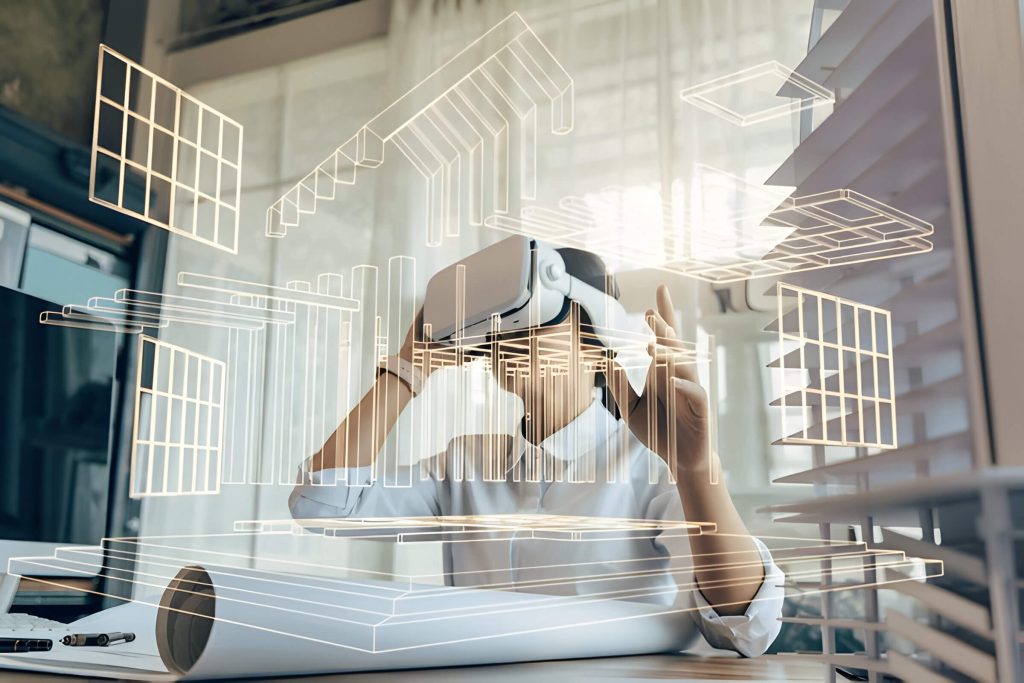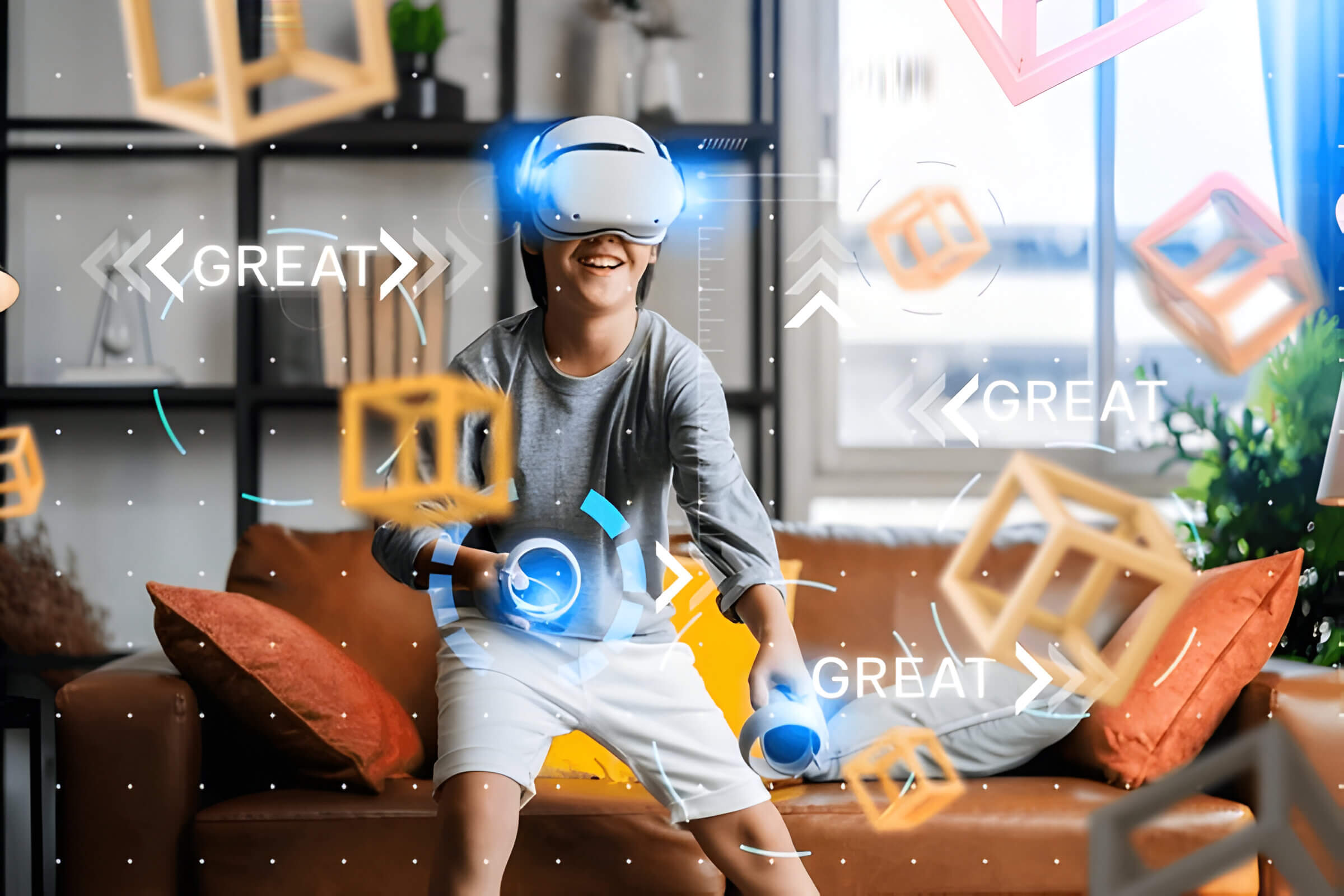Virtual Reality (VR) is a groundbreaking technology that immerses users in computer-generated worlds. It combines advanced hardware and software to create lifelike experiences engaging multiple senses. VR is revolutionizing industries and enhancing human-computer interaction. We’ll examine its components, capabilities, challenges, and future potential.
Understanding the Basics of Virtual Reality
Virtual reality is a cutting-edge technology that creates immersive, computer-generated simulations of three-dimensional environments. At its core, VR aims to provide users with a fully interactive digital experience that engages multiple senses, primarily sight and sound. This technology utilizes specialized hardware, such as head-mounted displays and motion-tracking sensors, to transport users into virtual worlds.
The key components of VR technology include:
- Head-mounted displays (HMDs): These devices cover the user’s eyes and display stereoscopic images, creating a 3D visual experience.
- Motion tracking: Sensors that detect the user’s movements and adjust the virtual environment accordingly.
- Controllers: Handheld devices that allow users to interact with objects in the virtual world.
- Audio systems: Spatial audio technology that enhances the sense of presence in the digital environment.
VR experiences can range from simple, static 360-degree videos to complex, interactive simulations. These digital environments have numerous applications across various industries, including gaming, education, healthcare, and architecture. As VR technology continues to advance, it promises to revolutionize how we interact with digital content and reshape our understanding of immersive experiences.
The Key Components of a Virtual Reality System
Virtual Reality (VR) systems are complex technological marvels that rely on several key components working in harmony to create immersive experiences. At the heart of any VR setup is the VR headset, which houses high-resolution displays and lenses to provide users with a stereoscopic 3D view of virtual environments. Motion tracking is another crucial element, typically achieved through a combination of internal sensors in the headset and external cameras or base stations that precisely monitor the user’s movements in real-time.
Controllers are essential input devices that allow users to interact with virtual objects and navigate through digital spaces. These often feature buttons, joysticks, and triggers, as well as their own motion sensors for accurate hand tracking. A network of sensors, both within the headset and placed around the user’s space, work together to ensure smooth and responsive tracking of head and body movements.
Powering the entire VR experience are high-performance graphics processing units (GPUs) that render complex 3D environments with minimal latency. These GPUs must be capable of maintaining high frame rates to prevent motion sickness and ensure a seamless experience.
Finally, VR software ties all these hardware components together. This includes the operating system, drivers, and applications that create and manage the virtual environments, handle user inputs, and process sensory feedback. As VR technology continues to evolve, these key components are constantly being refined to deliver increasingly realistic and engaging virtual experiences.
How Virtual Reality Creates Immersive Experiences
Virtual Reality (VR) technology creates immersive experiences by engaging multiple senses simultaneously. At the core of VR are 3D stereoscopic displays, which present slightly different images to each eye, mimicking how we naturally perceive depth. These displays typically offer a wide field of view, often exceeding 100 degrees, to envelop the user’s peripheral vision.
High refresh rates, usually 90Hz or above, and low latency are crucial for maintaining the illusion of presence and preventing motion sickness. These factors ensure smooth visual updates as users move their heads, creating a more realistic and comfortable experience.
Spatial audio plays a significant role in VR immersion, providing directional sound cues that match the virtual environment. This technology helps users locate objects and events within the virtual space, enhancing the sense of presence.
Haptic feedback, through controllers or wearable devices, adds a tactile dimension to VR experiences. By simulating touch and resistance, haptic technology allows users to interact with virtual objects in a more intuitive and realistic manner.
Together, these elements create a multi-sensory experience that tricks the brain into believing it’s present in a virtual world, making VR an powerful tool for entertainment, education, and various industries.
The Technical Process Behind Virtual Reality
Virtual reality (VR) technology relies on a complex interplay of various technical processes to create immersive experiences. Rendering is at the core of VR, where powerful graphics processors generate high-quality, real-time visuals for each eye. Head tracking is crucial for maintaining the illusion of presence, using sensors to detect and respond to the user’s head movements. This is often complemented by eye tracking, which enhances the realism by adjusting focus and depth of field based on where the user is looking.
Motion tracking extends beyond the head, capturing the movements of the user’s body and limbs to translate them into the virtual environment. Positional tracking takes this a step further, monitoring the user’s location within a defined space, allowing for more natural navigation in VR. Spatial mapping is another key component, where the system scans and recreates the physical environment in the virtual world, enabling mixed reality experiences and preventing collisions with real-world objects.
These technologies work in concert to create a seamless, responsive, and believable virtual experience, constantly processing vast amounts of data to maintain the illusion of being present in another reality.
Applications of Virtual Reality Across Industries

Virtual Reality (VR) technology has revolutionized numerous industries, offering immersive experiences and innovative solutions.
- In gaming, VR provides players with unparalleled levels of engagement, transporting them into virtual worlds.
- The education sector has embraced VR for interactive learning experiences, allowing students to explore historical sites or conduct virtual science experiments.
- Medical professionals utilize VR for surgical training and patient rehabilitation, enhancing skills and treatment outcomes.
- Companies have adopted virtual reality training programs to simulate real-world scenarios, improving employee performance and safety.
- Architects and designers leverage VR to create and showcase 3D models, enabling clients to visualize spaces before construction begins.
- The tourism industry has also tapped into VR’s potential, offering virtual tours of destinations and attractions, allowing travelers to preview locations before booking.
As VR technology continues to advance, its applications across industries are likely to expand, driving innovation and transforming user experiences in countless fields.
Challenges and Limitations of Current VR Technology
Current VR technology, while promising, faces several significant challenges and limitations. Motion sickness remains a persistent issue for many users, caused by the disconnect between visual input and physical movement. Hardware limitations, such as bulky headsets and the need for powerful computing systems, can hinder widespread adoption and user comfort.
Content creation for VR environments presents unique challenges, requiring specialized skills and resources to produce immersive, high-quality experiences. This can lead to a shortage of diverse and engaging content, potentially slowing user adoption rates.
Accessibility issues also plague VR technology, as it may not be suitable for individuals with certain physical disabilities or visual impairments. This raises concerns about inclusivity and equal access to VR experiences.
Cost factors continue to be a significant barrier to entry for many consumers and businesses. High-end VR systems and accessories can be prohibitively expensive, limiting the technology’s reach to a broader audience.
As the industry works to address these challenges, advancements in hardware design, content creation tools, and accessibility features will be crucial for the continued growth and adoption of VR technology.
The Future of Virtual Reality
The future of virtual reality (VR) is poised for groundbreaking advancements, with several emerging trends and innovations set to revolutionize the industry. Wireless VR technology is gaining traction, eliminating the need for cumbersome cables and enhancing user mobility. This development is closely tied to the integration of augmented reality (AR), blurring the lines between virtual and real-world experiences.
Haptic suits are another exciting innovation, allowing users to feel physical sensations corresponding to their virtual interactions. These full-body wearables promise to add a new dimension of immersion to VR experiences. Meanwhile, brain-computer interfaces (BCIs) are pushing the boundaries of how we interact with virtual environments, potentially enabling direct neural control of virtual objects and avatars.
Photorealistic rendering techniques are rapidly improving, creating virtual worlds that are increasingly indistinguishable from reality. This advancement not only enhances gaming experiences but also opens up new possibilities for virtual training, education, and therapeutic applications.
As these technologies continue to evolve and converge, we can expect VR to become more accessible, immersive, and integral to various aspects of our daily lives, from entertainment and education to healthcare and professional training.






